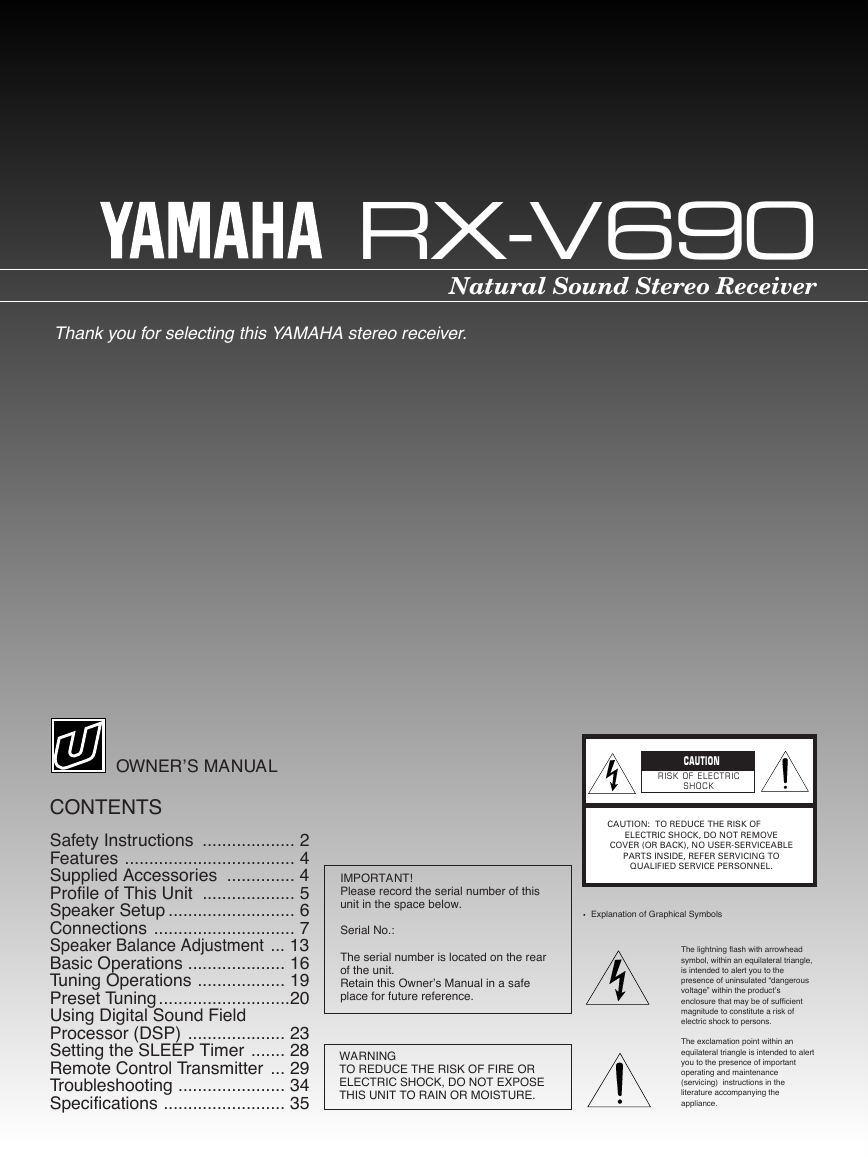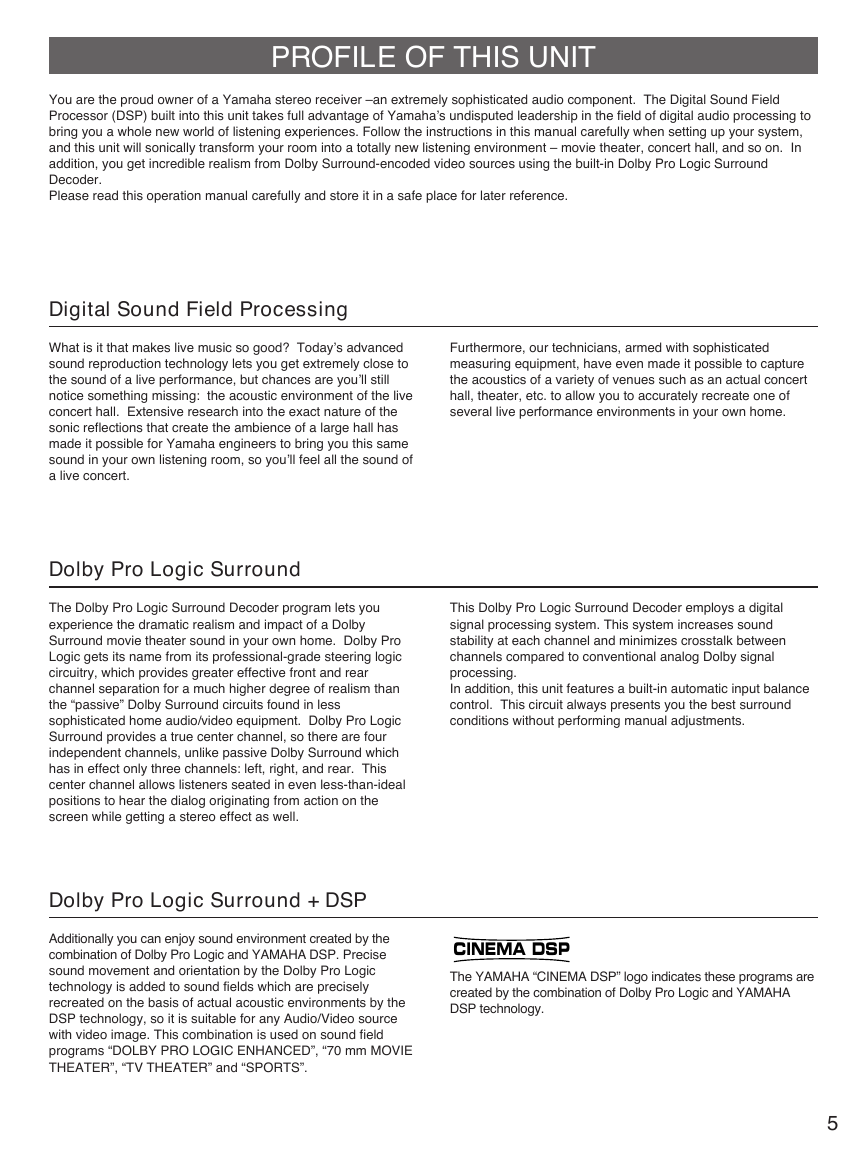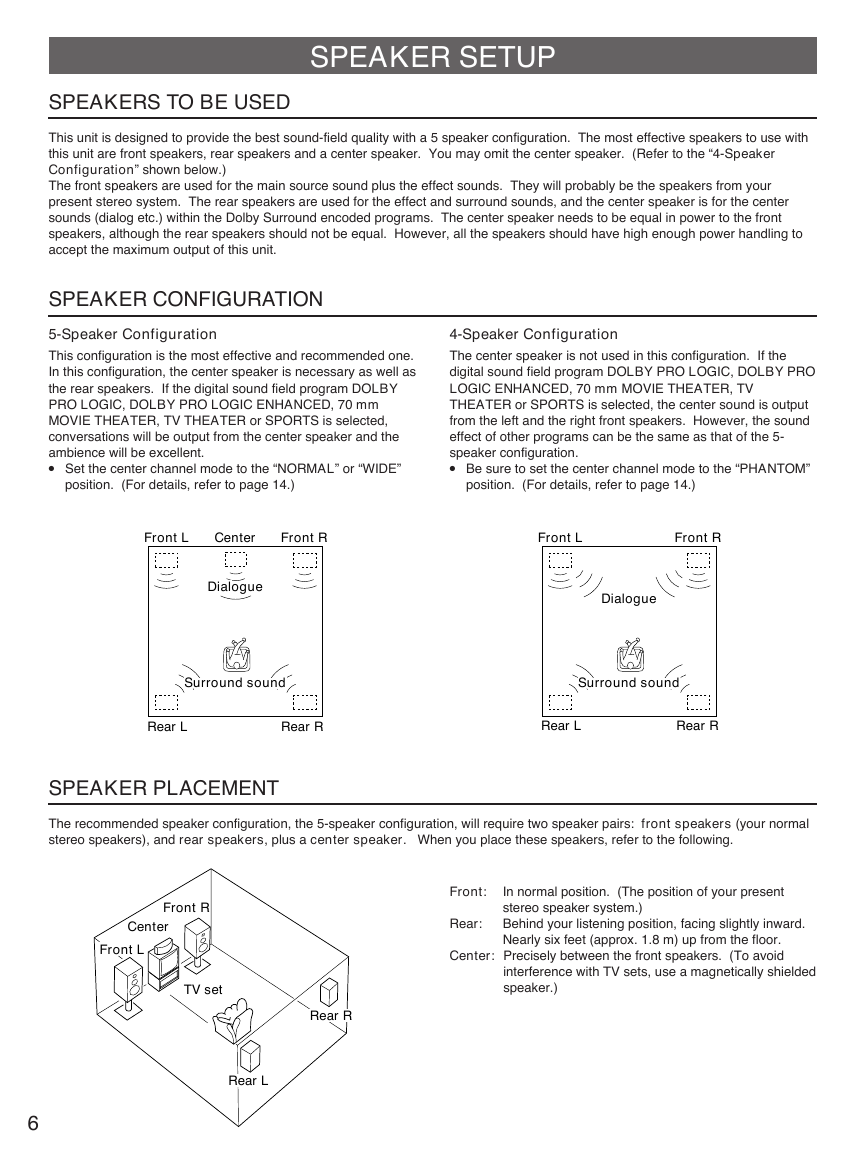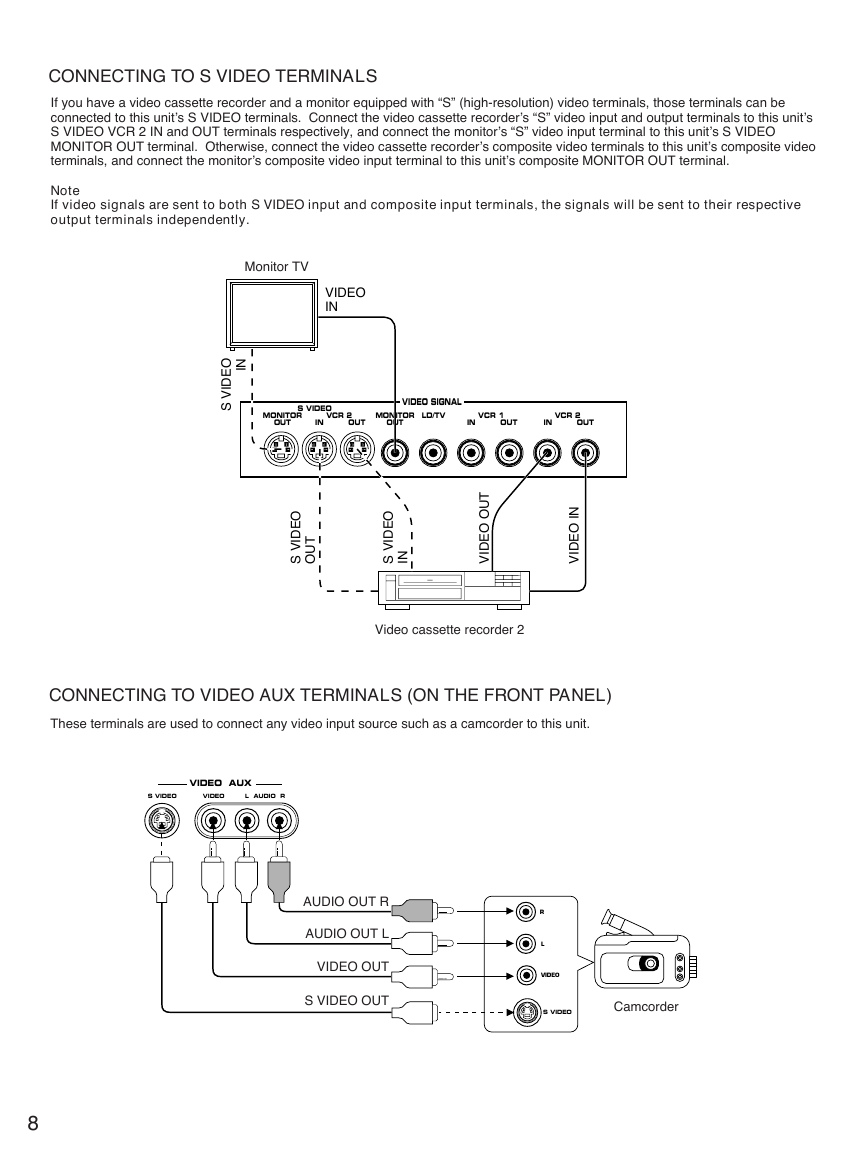RX-V690
Natural Sound Stereo Receiver
Thank you for selecting this YAMAHA stereo receiver.
OWNER’S MANUAL
CONTENTS
Safety Instructions ................... 2
Features ................................... 4
Supplied Accessories .............. 4
Profile of This Unit ................... 5
Speaker Setup .......................... 6
Connections ............................. 7
Speaker Balance Adjustment ... 13
Basic Operations .................... 16
Tuning Operations .................. 19
Preset Tuning ...........................20
Using Digital Sound Field
Processor (DSP) .................... 23
Setting the SLEEP Timer ....... 28
Remote Control Transmitter ... 29
Troubleshooting ...................... 34
Specifications ......................... 35
IMPORTANT!
Please record the serial number of this
unit in the space below.
Serial No.:
The serial number is located on the rear
of the unit.
Retain this Owner’s Manual in a safe
place for future reference.
WARNING
TO REDUCE THE RISK OF FIRE OR
ELECTRIC SHOCK, DO NOT EXPOSE
THIS UNIT TO RAIN OR MOISTURE.
CAUTION
RISK OF ELECTRIC
SHOCK
CAUTION: TO REDUCE THE RISK OF
ELECTRIC SHOCK, DO NOT REMOVE
COVER (OR BACK), NO USER-SERVICEABLE
PARTS INSIDE, REFER SERVICING TO
QUALIFIED SERVICE PERSONNEL.
• Explanation of Graphical Symbols
The lightning flash with arrowhead
symbol, within an equilateral triangle,
is intended to alert you to the
presence of uninsulated “dangerous
voltage” within the product’s
enclosure that may be of sufficient
magnitude to constitute a risk of
electric shock to persons.
The exclamation point within an
equilateral triangle is intended to alert
you to the presence of important
operating and maintenance
(servicing) instructions in the
literature accompanying the
appliance.
�
SAFETY INSTRUCTIONS
1 Read Instructions – All the safety and operating
instructions should be read before the unit is operated.
A. The power-supply cord or the plug has been damaged;
or
2 Retain Instructions – The safety and operating instructions
should be retained for future reference.
B. Objects have fallen, or liquid has been spilled into the unit;
or
3 Heed Warnings – All warnings on the unit and in the
operating instructions should be adhered to.
C. The unit has been exposed to rain; or
4
Follow Instructions – All operating and other instructions
should be followed.
5 Water and Moisture – The unit should not be used near
water – for example, near a bathtub, washbowl, kitchen
sink, laundry tub, in a wet basement, or near a swimming
pool, etc.
6 Carts and Stands – The unit should be used only with a
cart or stand that is recommended by the manufacturer.
6A A unit and cart combination should
be moved with care. Quick stops,
excessive force, and uneven
surfaces may cause the unit and
cart combination to overturn.
7 Wall or Ceiling Mounting – The unit
should be mounted to a wall or ceiling only as
recommended by the manufacturer.
8
Ventilation – The unit should be situated so that its
location or position does not interfere with its proper
ventilation. For example, the unit should not be situated
on a bed, sofa, rug, or similar surface, that may block the
ventilation openings; or placed in a built-in installation,
such as a bookcase or cabinet that may impede the flow
of air through the ventilation openings.
9 Heat – The unit should be situated away from heat
sources such as radiators, stoves, or other appliances that
produce heat.
10 Power Sources – The unit should be connected to a power
supply only of the type described in the operating
instructions or as marked on the unit.
11 Power-Cord Protection – Power-supply cords should be
routed so that they are not likely to be walked on or
pinched by items placed upon or against them, paying
particular attention to cords at plugs, convenience
receptacles, and the point where they exit from the unit.
12 Cleaning – The unit should be cleaned only as
recommended by the manufacturer.
13 Nonuse Periods – The power cord of the unit should be
unplugged from the outlet when left unused for a long
period of time.
14 Object and Liquid Entry – Care should be taken so that
objects do not fall into and liquids are not spilled into the
inside of the unit.
15 Damage Requiring Service – The unit should be serviced
by qualified service personnel when:
D. The unit does not appear to operate normally or exhibits a
marked change in performance; or
E. The unit has been dropped, or the cabinet damaged.
16 Servicing – The user should not attempt to service the unit
beyond those means described in the operating
instructions. All other servicing should be referred to
qualified service personnel.
17 Power Lines – An outdoor antenna should be located
away from power lines.
18 Grounding or Polarization – Precautions should be taken
so that the grounding or polarization is not defeated.
19 Outdoor Antenna Grounding – If an outside antenna is
connected to this unit, be sure the antenna system is
grounded so as to provide some protection against voltage
surges and built-up static charges. Article 810 of the
National Electrical Code, ANSI/NFPA 70, provides
information with regard to proper grounding of the mast
and supporting structure, grounding of the lead-in wire to
an antenna discharge unit, size of grounding conductors,
location of antenna discharge unit, connection to
grounding electrodes, and requirements for the grounding
electrode.
EXAMPLE OF ANTENNA GROUNDING
MAST
GROUND
CLAMP
ELECTRIC
SERVICE
EQUIPMENT
NEC – NATIONAL ELECTRICAL CODE
ANTENNA
LEAD IN
WIRE
ANTENNA
DISCHARGE UNIT
(NEC SECTION 810–20)
GROUNDING CONDUCTORS
(NEC SECTION 810–21)
GROUND CLAMPS
POWER SERVICE GROUNDING
ELECTRODE SYSTEM
(NEC ART 250. PART H)
Note to CATV system installer:
This reminder is provided to call the CATV system
installer's attention to Article 820-40 of the NEC that
provides guidelines for proper grounding and, in
particular, specifies that the cable ground shall be
connected to the grounding system of the building, as
close to the point of cable entry as practical.
2
�
Caution: Read this before operating your unit
1
2
To assure the finest performance, please read this
manual carefully. Keep it in a safe place for future
reference.
Install this unit in a cool, dry, clean place – away from
windows, heat sources, sources of excessive vibration,
dust, moisture and cold. Avoid sources of humming
(transformers, motors). To prevent fire or electrical
shock, do not expose the unit to rain or water.
3 Do not operate the unit upside-down. It may overheat,
possibly causing damage.
4 Never open the cabinet. If something drops into the set,
contact your dealer.
5 Do not use force on switches, controls or connection
wires. When moving the unit, first disconnect the power
plug and the wires connected to other equipment.
Never pull the wires themselves.
7
6 Do not attempt to clean the unit with chemical solvents;
this might damage the finish. Use a clean, dry cloth.
Always set the VOLUME control to “– ∞” before starting
the audio source play. Increase the volume gradually to
an appropriate level after the play back has been
started.
To prevent lightning damage, pull out the power cord
and remove the antenna cable during an electrical
storm.
Be sure to read the “TROUBLESHOOTING” section
regarding common operating errors before concluding
that the unit is faulty.
8
9
10 AC outlet
Do not connect audio equipment to the AC outlet on the
rear panel if that equipment requires more power than
the outlet is rated to provide.
FCC INFORMATION
1.
2.
IMPORTANT NOTICE : DO NOT MODIFY THIS UNIT!
This product, when installed as indicated in the
instructions contained in this manual, meets FCC
requirements. Modifications not expressly approved by
Yamaha may void your authority, granted by the FCC, to
use the product.
IMPORTANT : When connecting this product to
accessories and/or another product use only high quality
shielded cables. Cable/s supplied with this product
MUST be used. Follow all installation instructions.
Failure to follow instructions could void your FCC
authorization to use this product in the USA.
3. NOTE : This product has been tested and found to
comply with the requirements listed in FCC Regulations,
Part 15 for Class “B” digital devices. Compliance with
these requirements provides a reasonable level of
assurance that your use of this product in a residential
environment will not result in harmful interference with
other electronic devices.
This equipment generates/uses radio frequencies and, if
not installed and used according to the instructions
found in the users manual, may cause interference
harmful to the operation of other electronic devices.
Compliance with FCC regulations does not guarantee that
interference will not occur in all installations. If this product
is found to be the source of interference, which can be
determined by turning the unit “OFF” and “ON”, please try
to eliminate the problem by using one of the following
measures:
Relocate either this product or the device that is being
affected by the interference.
Utilize power outlets that are on different branch (circuit
breaker or fuse) circuits or install AC line filter/s.
In the case of radio or TV interference, relocate/reorient the
antenna. If the antenna lead-in is 300 ohm ribbon lead,
change the lead-in to coaxial type cable.
If these corrective measures do not produce satisfactory
results, please contact the local retailer authorized to
distribute this type of product. If you can not locate the
appropriate retailer, please contact Yamaha Electronics
Corp., U.S.A. 6660 Orangethorpe Ave, Buena Park, CA
90620.
The above statements apply ONLY to those products
distributed by Yamaha Corporation of America or its
subsidiaries.
We Want You Listening For A Lifetime
YAMAHA and the Electronic Industries Association’s
Consumer Electronics Group want you to get the most out of
your equipment by playing it at a safe level. One that lets the
sound come through loud and clear without annoying blaring or
distortion – and, most importantly, without
affecting your sensitive hearing. Since hearing
damage from loud sounds is often undetectable
until it is too late, YAMAHA and the Electronic
Industries Association’s Consumer Electronics
Group recommend you to avoid prolonged
exposure from excessive volume levels.
3
�
FEATURES
l 5 Speaker Configuration
Front:
(U.S.A. and Canada models)
80W + 80W (8Ω) RMS Output
Power, 0.04% THD, 20–20,000 Hz
(Australia, Singapore and
General models)
75W + 75W (8Ω) RMS Output
Power, 0.04% THD, 20–20,000 Hz
Center: (U.S.A. and Canada models)
80W (8Ω) RMS Output
Power, 0.07% THD, 1 kHz
(Australia, Singapore and
General models)
80W (8Ω) RMS Output
Power, 0.07% THD, 1 kHz
25W + 25W (8Ω) RMS Output
Power, 0.3% THD, 1 kHz
Rear:
l Digital Sound Field Processor (Including
Dolby Pro Logic Surround Decoder)
5 Programs for Audio Sources
5 Programs for Audio/Video Sources
l Automatic Input Balance Control for
Dolby Surround
l Test Tone Generator for Easier Speaker
Balance Adjustment
l 3 Center Channel Modes
(NORMAL/WIDE/PHANTOM)
l 40-Station Random Access Preset
Tuning
l Automatic Preset Tuning
l Preset Station Shifting Capability (Preset
Editing)
l IF Count Direct PLL Synthesizer Tuning
System
l SLEEP Timer
l Video Signal Input/Output Capability
(Including S Video Connections)
l Programmable Remote Control
Transmitter
SUPPLIED ACCESSORIES
After unpacking, check that the following parts are contained.
Remote Control Transmitter
Batteries (size AA, R6, UM-3)
Indoor FM Antenna
User Program Sheets
AM Loop Antenna
4
�
PROFILE OF THIS UNIT
You are the proud owner of a Yamaha stereo receiver –an extremely sophisticated audio component. The Digital Sound Field
Processor (DSP) built into this unit takes full advantage of Yamaha’s undisputed leadership in the field of digital audio processing to
bring you a whole new world of listening experiences. Follow the instructions in this manual carefully when setting up your system,
and this unit will sonically transform your room into a totally new listening environment – movie theater, concert hall, and so on. In
addition, you get incredible realism from Dolby Surround-encoded video sources using the built-in Dolby Pro Logic Surround
Decoder.
Please read this operation manual carefully and store it in a safe place for later reference.
Digital Sound Field Processing
What is it that makes live music so good? Today’s advanced
sound reproduction technology lets you get extremely close to
the sound of a live performance, but chances are you’ll still
notice something missing: the acoustic environment of the live
concert hall. Extensive research into the exact nature of the
sonic reflections that create the ambience of a large hall has
made it possible for Yamaha engineers to bring you this same
sound in your own listening room, so you’ll feel all the sound of
a live concert.
Dolby Pro Logic Surround
The Dolby Pro Logic Surround Decoder program lets you
experience the dramatic realism and impact of a Dolby
Surround movie theater sound in your own home. Dolby Pro
Logic gets its name from its professional-grade steering logic
circuitry, which provides greater effective front and rear
channel separation for a much higher degree of realism than
the “passive” Dolby Surround circuits found in less
sophisticated home audio/video equipment. Dolby Pro Logic
Surround provides a true center channel, so there are four
independent channels, unlike passive Dolby Surround which
has in effect only three channels: left, right, and rear. This
center channel allows listeners seated in even less-than-ideal
positions to hear the dialog originating from action on the
screen while getting a stereo effect as well.
Dolby Pro Logic Surround + DSP
Additionally you can enjoy sound environment created by the
combination of Dolby Pro Logic and YAMAHA DSP. Precise
sound movement and orientation by the Dolby Pro Logic
technology is added to sound fields which are precisely
recreated on the basis of actual acoustic environments by the
DSP technology, so it is suitable for any Audio/Video source
with video image. This combination is used on sound field
programs “DOLBY PRO LOGIC ENHANCED”, “70 mm MOVIE
THEATER”, “TV THEATER” and “SPORTS”.
Furthermore, our technicians, armed with sophisticated
measuring equipment, have even made it possible to capture
the acoustics of a variety of venues such as an actual concert
hall, theater, etc. to allow you to accurately recreate one of
several live performance environments in your own home.
This Dolby Pro Logic Surround Decoder employs a digital
signal processing system. This system increases sound
stability at each channel and minimizes crosstalk between
channels compared to conventional analog Dolby signal
processing.
In addition, this unit features a built-in automatic input balance
control. This circuit always presents you the best surround
conditions without performing manual adjustments.
CINEMA DSP
The YAMAHA “CINEMA DSP” logo indicates these programs are
created by the combination of Dolby Pro Logic and YAMAHA
DSP technology.
5
�
SPEAKER SETUP
SPEAKERS TO BE USED
This unit is designed to provide the best sound-field quality with a 5 speaker configuration. The most effective speakers to use with
this unit are front speakers, rear speakers and a center speaker. You may omit the center speaker. (Refer to the “4-Speaker
Configuration” shown below.)
The front speakers are used for the main source sound plus the effect sounds. They will probably be the speakers from your
present stereo system. The rear speakers are used for the effect and surround sounds, and the center speaker is for the center
sounds (dialog etc.) within the Dolby Surround encoded programs. The center speaker needs to be equal in power to the front
speakers, although the rear speakers should not be equal. However, all the speakers should have high enough power handling to
accept the maximum output of this unit.
SPEAKER CONFIGURATION
5-Speaker Configuration
This configuration is the most effective and recommended one.
In this configuration, the center speaker is necessary as well as
the rear speakers. If the digital sound field program DOLBY
PRO LOGIC, DOLBY PRO LOGIC ENHANCED, 70 mm
MOVIE THEATER, TV THEATER or SPORTS is selected,
conversations will be output from the center speaker and the
ambience will be excellent.
l Set the center channel mode to the “NORMAL” or “WIDE”
position. (For details, refer to page 14.)
4-Speaker Configuration
The center speaker is not used in this configuration. If the
digital sound field program DOLBY PRO LOGIC, DOLBY PRO
LOGIC ENHANCED, 70 mm MOVIE THEATER, TV
THEATER or SPORTS is selected, the center sound is output
from the left and the right front speakers. However, the sound
effect of other programs can be the same as that of the 5-
speaker configuration.
l Be sure to set the center channel mode to the “PHANTOM”
position. (For details, refer to page 14.)
Front L
Center
Front R
Front L
Front R
Dialogue
Dialogue
Dialogue
Dialogue
Surround sound
Surround sound
Surround sound
Surround sound
Rear L
Rear R
Rear L
Rear R
SPEAKER PLACEMENT
The recommended speaker configuration, the 5-speaker configuration, will require two speaker pairs: front speakers (your normal
stereo speakers), and rear speakers, plus a center speaker. When you place these speakers, refer to the following.
Front:
Rear:
In normal position. (The position of your present
stereo speaker system.)
Behind your listening position, facing slightly inward.
Nearly six feet (approx. 1.8 m) up from the floor.
Center: Precisely between the front speakers. (To avoid
interference with TV sets, use a magnetically shielded
speaker.)
Front R
Center
Front L
TV set
Rear R
Rear L
6
�
CONNECTIONS
Before attempting to make any connections to or from this unit, be sure to first switch OFF the power to this unit and to any other
components to which connections are being made.
CONNECTIONS WITH OTHER COMPONENTS
When making connections between this unit and other components, be sure all connections are made correctly, that is to say L (left)
to L, R (right) to R, “+” to “+” and “–” to “–”. Also, refer to the owner’s manual for each component to be connected to this unit.
Turntable
Monitor TV
LD player,
TV tuner, etc.
Video cassette recorder 2
N
I
O
E
D
V
I
N
I
I
O
D
U
A
T
U
O
O
D
U
A
I
T
U
O
O
E
D
V
I
T
U
O
O
D
U
A
I
D
N
G
T
U
P
T
U
O
N
I
O
E
D
V
I
T
U
O
O
E
D
V
I
GND
75W UNBAL.
8W MIN.
/SPEAKER
REAR
CENTER
FM
ANT
GND
AM
ANT
S VIDEO
MONITOR
OUT
IN
VCR 2
OUT
VIDEO SIGNAL
MONITOR
OUT
LD/TV
VCR 1
OUT
IN
VCR 2
OUT
IN
C D:4W MIN./SPEAKER
SINGLE:8W MIN./SPEAKER
C
D
DUAL
SINGLE
SPEAKERS
SPEAKERS
A
B
IN
OUT
VCR 1
IN
OUT
VCR 2
FRONT
PHONO
CD
TAPE
PB
REC
OUT
TAPE
AUDIO SIGNAL
LD/TV
(U.S.A. model)
AC OUTLETS
SWITCHED
I20W MAX. TOTAL
l20W MAX. TOTAL
I.0A MAX. TOTAL
MAINS
OUTPUT
FRONT CENTER REAR
LOW
PASS
fc:200Hz
A
B
A OR B:8W MIN.
/SPEAKER
A B:l6W MIN.
/SPEAKER
T
U
P
T
U
O
T
U
O
E
N
I
L
N
I
E
N
I
L
T
U
O
O
E
D
V
I
T
U
O
O
D
U
A
I
To AC outlet
N
I
I
O
D
U
A
N
I
O
E
D
V
I
CD player
Tape deck
Video cassette recorder 1
: Refer to “ABOUT THE ACCESSORY TERMINALS” on page 11.
7
�
CONNECTING TO S VIDEO TERMINALS
If you have a video cassette recorder and a monitor equipped with “S” (high-resolution) video terminals, those terminals can be
connected to this unit’s S VIDEO terminals. Connect the video cassette recorder’s “S” video input and output terminals to this unit’s
S VIDEO VCR 2 IN and OUT terminals respectively, and connect the monitor’s “S” video input terminal to this unit’s S VIDEO
MONITOR OUT terminal. Otherwise, connect the video cassette recorder’s composite video terminals to this unit’s composite video
terminals, and connect the monitor’s composite video input terminal to this unit’s composite MONITOR OUT terminal.
Note
If video signals are sent to both S VIDEO input and composite input terminals, the signals will be sent to their respective
output terminals independently.
Monitor TV
VIDEO
IN
N
I
O
E
D
V
S
I
MONITOR
OUT
IN
S VIDEO
VCR 2
OUT
VIDEO SIGNAL
MONITOR
OUT
LD/TV
VCR 1
OUT
IN
VCR 2
OUT
IN
O
E
D
V
S
I
T
U
O
O
E
D
V
S
I
N
I
T
U
O
O
E
D
V
I
N
I
O
E
D
V
I
Video cassette recorder 2
CONNECTING TO VIDEO AUX TERMINALS (ON THE FRONT PANEL)
These terminals are used to connect any video input source such as a camcorder to this unit.
VIDEO AUX
S VIDEO
VIDEO
L AUDIO R
AUDIO OUT R
AUDIO OUT L
VIDEO OUT
S VIDEO OUT
R
L
VIDEO
S VIDEO
Camcorder
8
�
















 2023年江西萍乡中考道德与法治真题及答案.doc
2023年江西萍乡中考道德与法治真题及答案.doc 2012年重庆南川中考生物真题及答案.doc
2012年重庆南川中考生物真题及答案.doc 2013年江西师范大学地理学综合及文艺理论基础考研真题.doc
2013年江西师范大学地理学综合及文艺理论基础考研真题.doc 2020年四川甘孜小升初语文真题及答案I卷.doc
2020年四川甘孜小升初语文真题及答案I卷.doc 2020年注册岩土工程师专业基础考试真题及答案.doc
2020年注册岩土工程师专业基础考试真题及答案.doc 2023-2024学年福建省厦门市九年级上学期数学月考试题及答案.doc
2023-2024学年福建省厦门市九年级上学期数学月考试题及答案.doc 2021-2022学年辽宁省沈阳市大东区九年级上学期语文期末试题及答案.doc
2021-2022学年辽宁省沈阳市大东区九年级上学期语文期末试题及答案.doc 2022-2023学年北京东城区初三第一学期物理期末试卷及答案.doc
2022-2023学年北京东城区初三第一学期物理期末试卷及答案.doc 2018上半年江西教师资格初中地理学科知识与教学能力真题及答案.doc
2018上半年江西教师资格初中地理学科知识与教学能力真题及答案.doc 2012年河北国家公务员申论考试真题及答案-省级.doc
2012年河北国家公务员申论考试真题及答案-省级.doc 2020-2021学年江苏省扬州市江都区邵樊片九年级上学期数学第一次质量检测试题及答案.doc
2020-2021学年江苏省扬州市江都区邵樊片九年级上学期数学第一次质量检测试题及答案.doc 2022下半年黑龙江教师资格证中学综合素质真题及答案.doc
2022下半年黑龙江教师资格证中学综合素质真题及答案.doc